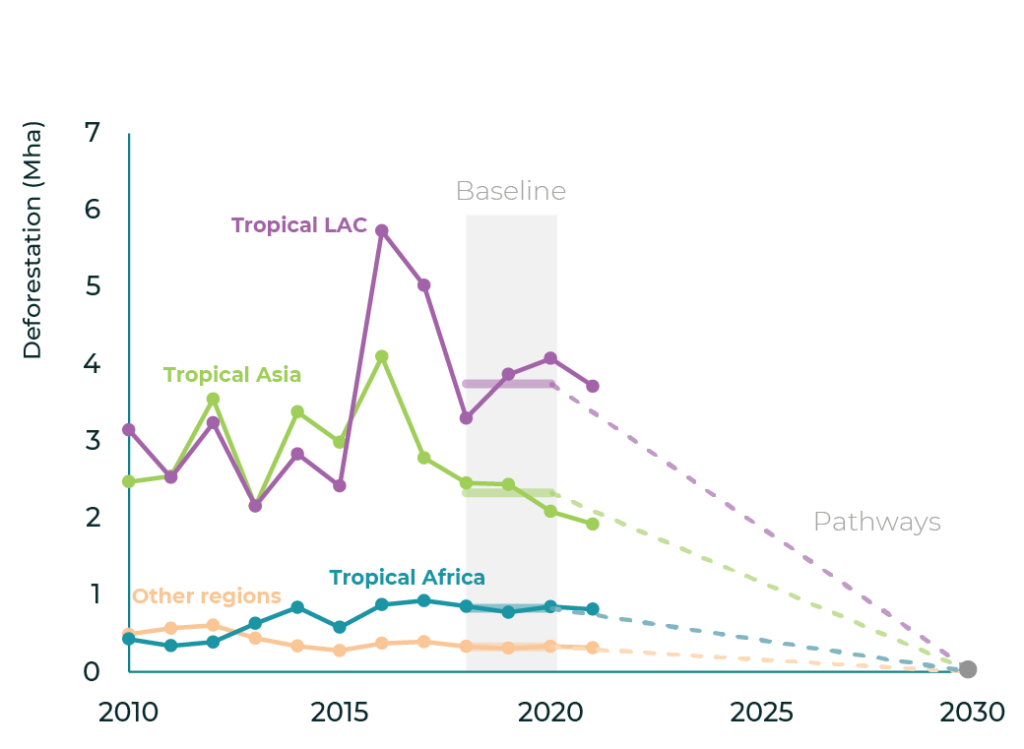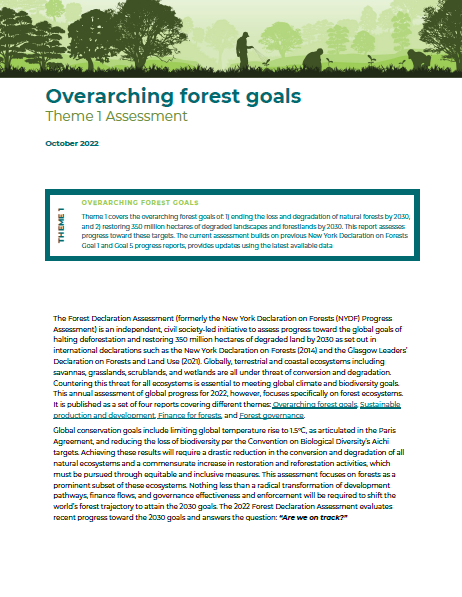Forests are fundamental to regulating and stabilizing the global climate. Meeting the Paris Agreement’s ambition of limiting global warming to no more than 1.5°C will require global greenhouse gas (GHG) emissions to reach net-zero by the second half of this century. Eliminating deforestation by 2030 is a major milestone towards achieving the 2050 net zero target. Land use change, including deforestation and degradation, accounts for 10-12 percent of global GHG emissions.[1] Protecting forests also comes with clear benefits for people, biodiversity, and sustainable development.[2]
Halting deforestation and forest degradation as soon as possible, and no later than 2030, will substantially reduce the release of terrestrial GHG emissions to the atmosphere. Restoring forests and other ecosystems will also return significant amounts of carbon to stored biomass and help us realize our collective 2030 targets.

Only eight years remain to achieve the twin global goals of halting and reversing deforestation by 2030. Despite encouraging signs, not a single global indicator is on track to meet these 2030 goals of of stopping forest loss and degradation and restoring 350 million hectares of forest landscape.
To be on course to halt deforestation completely by 2030, a 10 percent annual reduction is needed. However, deforestation rates around the world declined only modestly, in 2021, by 6.3 percent compared to the 2018-20 baseline. In the humid tropics, loss of irreplaceable primary forest decreased by Globally, forests became more degraded in 2021, but more slowly than during the 2018-20 baseline period; if continued, this slowdown may in time put the world on track to meet the 2030 target. There is also a significant year-to-year fluctuation in both deforestation and degradation metrics, which makes it difficult to detect trends over short periods of time. Future Assessments will continue to monitor these processes to confirm the limited progress detected in 2021.
Tropical Asia is the only region currently on track to halt deforestation by 2030 (see Figure). While deforestation rates in Tropical Latin America and Africa decreased in 2021 relative to the 2018-20 baseline, those reductions are still insufficient to meet the 2030 goal. Each year that passes without sufficient progress makes it increasingly difficult to meet global forest protection goals—and increases the annual reductions required in future years.
Notable progress in afforestation and reforestation efforts over the last two decades have resulted in new forest new forest areas the size of Peru, with net gains of forest cover in 36 countries. However, overall losses exceeded gains over the same period, resulting in a net loss of 100 million hectares globally. It should be noted that forest cover gains, through reforestation and afforestation activities, do not compensate for forest loss in terms of carbon storage, biodiversity, or ecosystem services. Therefore, highest priority efforts should be directed towards safeguarding primary forests from losses in the first place.
| Figure: Global deforestation rate by region over the 2010-2021 period, in million hectares, and the pathway to reach the 2030 gross zero target from the 2018-2020 baseline |

[1] IPCC. (2014). Climate Change 2014: Synthesis Report. Contribution of Working Groups I, II and III to the Fifth Assessment Report of the Intergovernmental Panel on Climate Change. https://www.ipcc.ch/report/ar5/syr/; IPCC. (2019). Climate Change and Land: an IPCC special report on climate change, desertification, land degradation, sustainable land management, food security, and greenhouse gas fluxes in terrestrial ecosystems. https://www.ipcc.ch/srccl/.
[2] Chao, S. (2012). Forest Peoples: Numbers across the world. https://www.forestpeoples.org/sites/fpp/files/publication/2012/05/forest-peoples-numbers-across-world-final_0.pdf; World Resources Institute & Climate Focus. (2022). Sink or swim: How Indigenous and community lands can make or break nationally determined contributions (p. 22). https://forestdeclaration.org/resources/sink-or-swim; Gibson, L., Lee, T.M., Koh, L.P., Brook, B.W., Gardner, T.A., Barlow, J., Peres, C.A., Bradshaw, C.J., Laurance, W.F., Lovejoy, T.E. & Sodhi, N.S. (2011). Primary forests are irreplaceable for sustaining tropical biodiversity. Nature, 478(7369), 378-381. https://doi.org/10.1038/nature10425
Only eight years remain to achieve the twin global goals of halting and reversing deforestation by 2030. Despite encouraging signs, not a single global indicator is on track to meet these 2030 goals of of stopping forest loss and degradation and restoring 350 million hectares of forest landscape.
The 2022 Forest Declaration Assessment sheds a stark light on the state of global forest commitments but offers hope that achieving the 2030 forest goals is possible. The Assessment is presented as series of four reports on Overarching forest goals (Theme 1), Sustainable production and development (Theme 2), Finance for forests (Theme 3), and Forest governance (Theme 4) -- all summarized in an Executive Summary.


